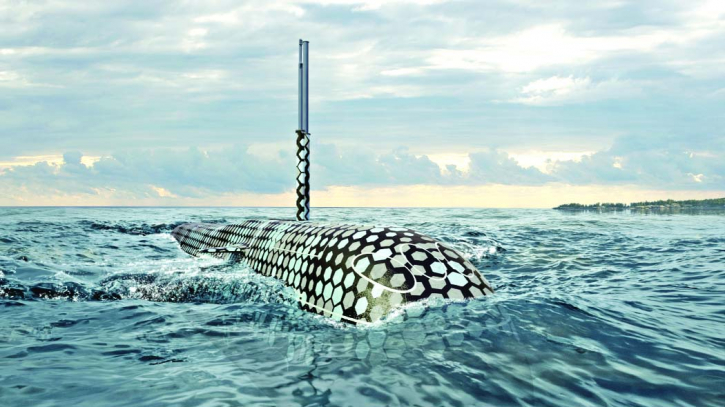
Rubin Design Bureau unveils a fully electric submarine with the displacement about 600 tones at the Army 2022 show, held on August 15-21 in Moscow. The project of the single-hull ship named Amur e600 belongs to the Amur class. The new design differs from other members of Amur class by its main power source: a high-capacity Li-Ion battery, complemented only by a small backup diesel-generator.
Speaking at the Army 2022, Andrey Baranov, deputy director general, Foreign Economic Activities at the Rubin Design Bureau, Russia's state-owned submarine designers, and his two other colleagues have explained about their products to the visiting journalists in the expo.
About the fully electric submarine, Andrey Baranov said, main features of the design are compact dimensions and high underwater endurance. Submarine can stay underwater for 14-17 days at 4 knots without snorkeling, being on par with much larger AIP-equipped submarines. Amur e600 range is about 1500 miles. The project is a real concentration of energy-efficient solutions; the most prominent one is its sailless design, contributing to drag reduction, he said.
He informed that huge capacity of modern Li-Ion batteries allows submarine to operate at any tactically advantageous speed within the total battery capability. Lacking the noisy battery charge mode, Amur 600e is ideal for ambushes in narrows and at barriers; as well as for reconnaissance or Special Forces delivery. The weaponry onboard is sufficient for defeating single targets or achieving a mission-kill at least. A lock-out chamber is installed to launch and recover Special Forces.
Owing to all these features, Amur e600 is well suited for enclosed and littoral seas. Even a possibility to meet this submarine will deter opposition and hinder amphibious, mining and other hostile operations. Amur e600 perfectly fits the modern network-centric operations: stealth contributes to the submarine's capability to target coordinated strikes of coastal and airborne assets.
Unlike AIP boats, the submarine is logistics-friendly, as she does not need refueling with chemical reagents, which reduces cost of ownership. Further development of battery technologies will allow Amur e600 to acquire new capabilities: to increase the payload, cruising range and other parameters.
Rubin Design Bureau also presents its concept of a cutting-edge extra large unmanned underwater vehicle (UUV) at the Army 2022 show. As the UUV is intended to cooperate with manned submarines, it was given a name Surrogate-W (Wingman). It is the elaboration of an ASW target Surrogate, which Rubin has presented earlier. The new modification has the same displacement, about 40 tones, and the advanced technologies implemented in the UUV guarantee a significant expansion of functions. With a new modification of a Li-ion battery the range is up to 800 miles. The UUV will have an option to recharge batteries on board of a mother ship, as well as at underwater docking stations. Another option under development is a fuel cells power plant.
Surrogate-W is to provide operational freedom of manned submarines, primarily by keeping and restoring their stealth. The Wingman will tackle the tasks that could compromise a Leader, such as communication, use of active sonar, etc. The Wingman may perform as a smart gateway between a submarine and the atmosphere, ensuring the covert data exchange and navigation fixes. Having received the data from the Leader, the UUV transfers it to a satellite. The data could be sent immediately or after a fixed period of time or when the UUV reaches a preassigned spot. An interaction with seabed network systems can be organized in the same way.
Surrogate-W is able to conduct ice reconnaissance under solid ice pack and minehunting in hazardous areas. It is much faster and safer to get the information through the UUV than by surveying an area with a submarine's onboard systems. Working autonomously, Surrogate-W gives the Leader time and space to solve other tasks while the UUV explores the region. Acoustic and non-acoustic search systems allow the Wingman to search for ships and submarines independently in specified areas or along vectors. Unlike a submarine, the UUV can acquire targets using overt methods, such as active sonars, since it is more than difficult to hit a UUV due to its size and maneuverability.
About the research underwater vehicle Klavesin-2R, which was demonstrates at Army 2022 show, the Rubin design bureau officials said, Mid-size research autonomous unmanned underwater vehicle (UUV) Klavesin-2R is designed for ocean exploration, oceanographic and geological survey at the ocean bottom. The vehicle can be used in any area of the World Ocean: littoral and sea areas as well as ocean zones. The development has been performed under the authority of the Ministry of Defence of the Russian Federation. Klavesin-2R is a four-ton deep-sea vehicle capable of diving and operating down to about six thousand meters. It features high sea endurance, operational range is not less than 150 km.
UUV Klavesin-2R can perform seabed surveys and automatic exploration of the object of interest by its digital photosystem. It records the information that can be later played back and processed by the operator on-board its carrier vessel. The vehicle is fully autonomous but, if need be, remote control can also be initiated through a hydroacoustic channel. Once the mission is completed, it surfaces in the designated area, establishes its position and communicates it to the carrier vessel. For ecological monitoring, Klavesin-2R measures water temperature, pressure and sound velocity within the range of its diving depth.
The vehicle has been developed and manufactured by Rubin Design Bureau using 3D simulation environment. Rubin fully develops its robotic underwater systems in a digital environment, which speeds up calculations, reduces concept-to-delivery time and makes it possible to avoid nearly all rejects during manufacture and assembly of the vehicle. Rubin Design Bureau is among world leaders in the design of nuclear and conventional submarines and the largest marine engineering company offering design services in Russia. 1066 submarines in 121 years of our work have been built to Rubin designs, including 950 submarines commissioned by the Russian Navy. Totally 116 submarines designed by Rubin have been exported to 16 countries.
Rubin also develops marine robotic systems and designs the facilities for offshore oil and gas field development. The company is a subsidiary of the state-owned United Shipbuilding Corporation. When the officials of the Rubin Design Bureau presented the ballistic missile submarines (SSBN) at the army 2022 show, they said, "The New SSBNs will replace SSBN Borey-A class not earlier than in the second part of the 21th century, so they will operate in different environment."
The shifts that could be anticipated today define the shape of Arcturus. Ongoing improvement of missile weaponry allows to reduce a number of missiles onboard while keeping the strike potential of the ship. Along with the new shape, these modifications will make Arcturus displacement 20% less than that of modern missile submarines. She will have length 134 meters, width 15.7 meters and complement of 100. Stealth will remain the defining feature of the SSBN, but as methods of detecting submarines evolve constantly, so the ways of ensuring stealth are to change too.
Noise reduction leads to active low-frequency systems playing an increasing role in detection. The new "faceted" shape of the Arcturus, together with size reduction and an advanced active coating, reduce the reflected sonar signal and diminish the detection range of the vessel. A distributed shaftless power plant with full electric propulsion brings down radiated noise, while two propulsors increase the maneuverability and reliability of the boat. These solutions make Arcturus especially suitable for operations in the most perspective region: high latitude Arctic. The interest in that theater will only go up in the nearest decades.
The faceted shape of the submarine simplifies breaking the ice during the surfacing and allows ice to slip from missile tube hatches. Improved maneuverability is important for taking a position under an ice hole.
In the army 2022, Rubin Design Bureau also showed a model of Remotely Operated Unmanned Underwater Work Class Vehicle KIT-3000 ("Whale"). They said that the vehicle is designed for various underwater works, such as offshore trunk line laying and maintenance.
KIT-3000 can be launched from diverse vessels and offshore drill units. The vehicle is capable of inspecting subsea wells, pipelines and valves, and it can detect and rectify defects, install and control subsea equipment at a depth of up to three thousand meters.
The vehicle is equipped with a set of manipulators, attachments, tools and a basket for transportation of collected samples.
The UUV operates automatically to the maximum extent possible. The operator intervenes occasionally to help maintain the specified depth or course, distance to the seabed and ensure dynamic positioning of the vehicle.
KIT-3000 is provided with an advanced computer vision system that includes HD video cameras and superpower LED lights. This helps the operator to work with high precision under low-light conditions of deep seas. Weight of the vehicle is five tons, which is in line with similar vehicles of the same class. The whole system can be easily transported, as the dimension of all its components in transport position does not exceed dimensions of a standard 20-foot container.
The International Army Games, initiated by the Russian Defense Ministry, have served as an international platform for militaries to exchange experience and strengthen cooperation.





































